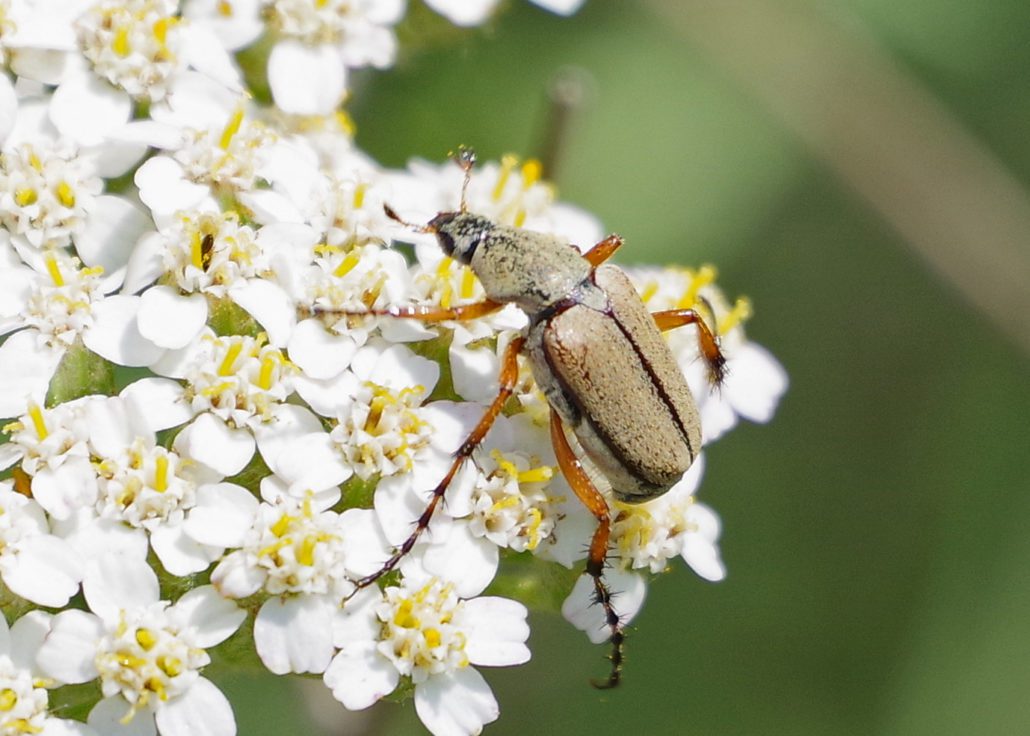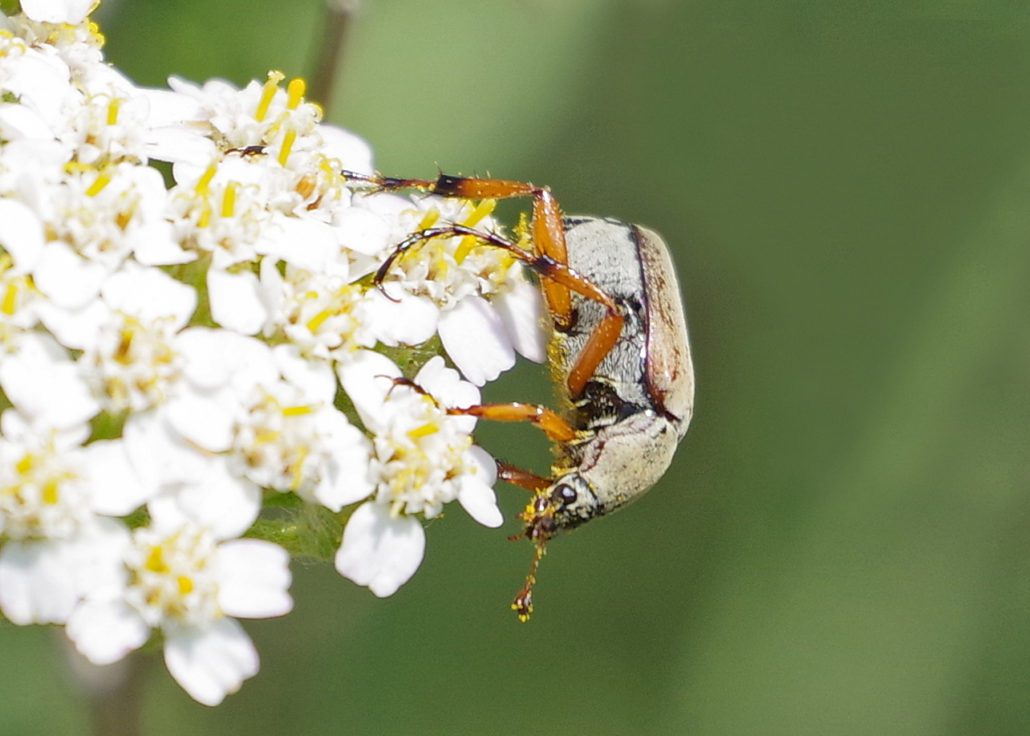
Red-belted Bumble Bee
Greetings, BugFans,
Isn’t this a pretty bee!!!
When you aim your camera at a bumble bee, which the BugLady does frequently, you expect to see black and yellow in varying proportions (the vaguaries of wind plus the bees’ perpetual motion results in lots of bumble bee shots on the cutting room floor). Four Wisconsin species – the Brown-belted https://bugguide.net/node/view/1752073/bgimage, the Rusty-patched https://bugguide.net/node/view/1857169/bgimage, the Tri-colored https://bugguide.net/node/view/1447937/bgimage, and the Red-belted bumble bee https://bugguide.net/node/view/405428/bgimage) have slightly different color schemes.
Bumble bees are in the diverse family Apidae, which also includes the Cuckoo, Carpenter, Digger, and Honey bees. According to bugguide.net, there are 47 species in the genus Bombus (15 in Wisconsin). The most recent bumble bee species to be described, Bombus kluanensis, was split from a known species (the “Active bumble bee,” Bombus neoboreus) in 2016 based on DNA analysis and is found only in the Yukon Territory and Denali National Park.
The BugLady photographed this bee on the prairie at Forest Beach Migratory Preserve. Her name is Bombus rufocinctus – the Red-belted bumble bee – and she’s a bee with somewhat northern inclinations plus a few disjunct eastern locations and minus the Great Plains https://bugguide.net/node/view/23380/data. RBBBs are bees of open spaces like grasslands, and they also like parks, gardens, barrens, and quarries. They are widespread but not common across their range (they make up about 10% of Wisconsin bumble bee records), and they’re found here mainly in the southern half of the state, though historical data suggest that they once occupied all of it.
The BugLady generally struggles with bumble bee identification, despite being able to photograph them and put them up on the monitor and agonize over them at leisure. RBBBs, with their short, round faces (one source says that they have a “cute, soft gestalt”), are noted for their many (many) color variations – up to 30 of them. “Can be confused with many species,” says the Bumble Bees of the Eastern United States. Here are a few RBBBs with varying amounts of red https://bugguide.net/node/view/1571134/bgimage, https://bugguide.net/node/view/820112/bgimage, https://bugguide.net/node/view/842376/bgimage, and one with none at all https://bugguide.net/node/view/2159342/bgimage.
Bumble bees are divided physiologically into short, medium, and long-tongued species. RBBBs are in the short-tongued group, which means that they feed on flowers whose nectar reward is not buried deep in tubular flowers. They’re generalists that are found on members of the aster, milkweed, geranium, rose, heath, and pea families, and more. They are good pollinators https://bugguide.net/node/view/980655/bgimage and in some areas are one of the native bee species that are vital pollinators of commercial blueberry crops.
Unlike honey bee nests, the shelf-life of bumble bee nests is less than a year. RBBBs have their nuptial flights in early August, when the colony’s population peaks; males claim territories around nectar sources and watch for queens, chasing intruders that fly past, bumble bee or not. Fertilized RBBB queens create hibernacula for themselves in the soil in fall and are the only bees from the nest that survive the winter.
They emerge from diapause (the term that’s used for invertebrate hibernation) in spring and look for a nest site. Many bumble bees nest underground in abandoned rodent burrows, but RBBBs often nest on and even above the ground, under bark or siding. The queen lays a dozen or so eggs and cares for them herself, and when these workers emerge, they take over the chores inside and outside the nest, and she is restricted to the nursery.
Her eggs are laid in wax cells that are not as tidy as those of honey bees. Workers feed protein (pollen) and carbs (nectar) to the larvae (nice series of pictures here https://bugguide.net/node/view/2090415/bgimage) as successive generations of workers take to the air.

RBBB nests may contain some “ringers.” Cuckoo bumble bees (formerly in the genus Psithyrus and now included in Bombus) take advantage of the labor of the worker bees by invading a bumble bee nest, killing the queen, and laying their own eggs in the nest. A few dominoes must be in place in order for the Cuckoo bumble bees to be successful brood parasites. In an article in Entomology Today titled “Cuckoo Bumble Bees: What We Can Learn From Their Cheating Ways (If They Don’t Go Extinct First)” author Meredith Swett Walker explains: “… cuckoo bumble bees are “obligate brood parasites”—in other words, they cannot reproduce without their hosts. They cannot produce their own workers, they lack pollen baskets on their legs and so cannot collect pollen to feed their own offspring, and they cannot produce enough wax to build their own nest.
Instead, cuckoo bumble bees must find a host colony of another bumble bee species, and it has to be just the right size. Too large, and there will be too many workers defending the nest and the cuckoo will be killed. Too small and there will be too few workers to raise the cuckoo’s offspring. So, cuckoo bumblebees must be selective. They also have to be tough fighters to defend themselves from attacking workers as they infiltrate the nest and kill the host queen. Thus, cuckoo bumble bees are heavily armored with larger and stronger mandibles, a hardened abdomen, and a thicker, more powerful sting.
After it infiltrates a nest, the invading cuckoo must defuse the battle and integrate into the host colony. Some cuckoo bumble bees do this by mimicking the chemical cues used by their host species. Other cuckoos produce few recognition chemicals of their own and then take on the “scent” of the colony via contact with nest materials and workers.
Finally, once hatched, cuckoo larvae must trick the host workers into feeding them. How this works is largely unknown. Previous research by Lhomme suggests that colonies taken over by cuckoo bumble bee queens may lose their ability to recognize outsiders in general and so be more accepting of cuckoo larvae when they hatch.”
Each species of Cuckoo bumble bee targets a few particular species of bumble bees and is similarly-colored, and along with the “dominoes” mentioned in Walker’s article, their flight period must sync with that of their potential host species. RBBBs are parasitized by the Indiscriminate Cuckoo bumble bee (B. insularis) and the Fernald/Flavid Cuckoo bumble bee (B. fernaldi/B. flavidus). The first is rare in Wisconsin and the second has been seen here only a few times in 50 years.
Yes, bumble bees can sting, and yes, they will sting, but unlike a honey bee’s barbed stinger that is pulled out when it stings (fatally, for the bee), bumble bees can sting multiple times to protect hearth and home (but not when you poke a camera in their face when they’re on a flower).
The BugLady loves this field guide https://www.xerces.org/publications/identification-and-monitoring-guides/bumble-bees-of-eastern-united-states and even has a paper copy.
Still some bumble bees out there.
Kate Redmond, The BugLady
Bug of the Week archives:
http://uwm.edu/field-station/category/bug-of-the-week/










































